Volvation
Volvation (from Latin volvere "roll", and the suffix -(a)tion; sometimes called enrollment), is a defensive behavior in certain animals, in which the animal rolls its own body into a ball, presenting only the hardest parts of its integument (the animal's "armor"), or its spines to predators.
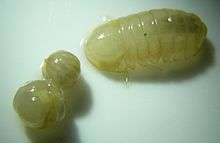
Among armadillos, only species in the genus Tolypeutes (South American three-banded armadillos) are able to roll into a defensive ball; the nine-banded armadillo and other species have too many plates.[1]
Volvation is used by earthworms during periods of extreme heat or drought.
Among pill millipeds, volvation is both a protection against external threats and against dehydration.[2]
Pillbugs curl themselves into "pills" not only for defense, but also to conserve moisture while resting or sleeping, because they must keep their pseudotrachaea ("gills") wet. Volvation is particularly well evolved in subterranean isopods, but only Caecosphaeroma burgundum is able to roll up into a hermetic sphere without any outward projections, and thus "approaches perfection in volvation".[3]
Gallery
- Examples of species that practice volvation:
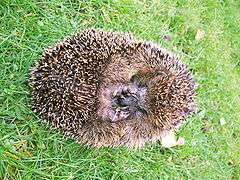 The European hedgehog (Erinaceus europaeus).
The European hedgehog (Erinaceus europaeus).- The Southern three-banded armadillo (Tolypeutes matacus).
.jpg) An Indian pangolin (Manis crassicaudata) defending itself against Asiatic lions (Panthera leo persica).
An Indian pangolin (Manis crassicaudata) defending itself against Asiatic lions (Panthera leo persica)._(10292363783).jpg) Two lesser hedgehog tenrecs (Echinops telfairi).
Two lesser hedgehog tenrecs (Echinops telfairi). Short-beaked echidna (Tachyglossus aculeatus) curling into a ball.
Short-beaked echidna (Tachyglossus aculeatus) curling into a ball.
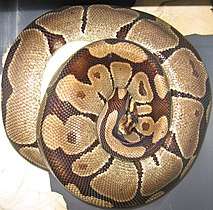 The ball python (Python regius) curls into a ball when stressed or frightened.
The ball python (Python regius) curls into a ball when stressed or frightened.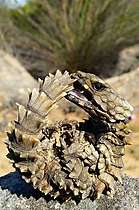 The armadillo girdled lizard (Ouroborus cataphractus).
The armadillo girdled lizard (Ouroborus cataphractus). The common pillbug (Armadillidium vulgare) is named after the pill it resembles when curled up.
The common pillbug (Armadillidium vulgare) is named after the pill it resembles when curled up.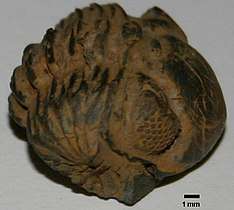
 Tachypodoiulus niger, a millipede, with legs on the inside and head in the center.
Tachypodoiulus niger, a millipede, with legs on the inside and head in the center.
 Stages of a pill millipede (Glomeris marginata) unrolling.
Stages of a pill millipede (Glomeris marginata) unrolling.
Bibliography
References
- "VOLVATION : Définition de VOLVATION" (in French). Centre national de ressources textuelles et lexicales (CNRTL: National Centre for Textual and Lexical Resources. Retrieved April 24, 2020..
- Jean-Michel Gobat; Michel Aragno; Willy Matthey (2010). Le sol vivant : bases de pédologie, biologie des sols (in French). 14 de Gérer l'environnement. PPUR Presses polytechniques. p. 817. ISBN 9782880747183. Retrieved April 24, 2020.
- Marvillet, C. "Les adaptations à la volvation du squelette externe de la tête chez Caecosphaeroma burgundum Dollfus, Crustacé Isopode des eaux souterraines". International Journal of Speleology. 8: 331–358. doi:10.5038/1827-806X.8.4.3. Retrieved April 22, 2020. (Article has English abstract.)